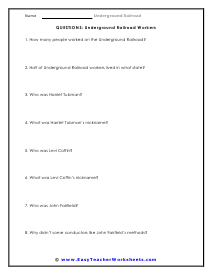The Underground Railroad was not underground or part of the railroad system at all. The name symbolized a movement in the nineteenth century U.S. that helped slaves find their way out of slavery. This secret cause was spearheaded by a wide variety of people, both black and white, which saw an injustice and worked to do something about it. This system helped slaves find safe passage to Canada or Free States.
These worksheets explore the people and events of Underground Railroad including: Harriet Tubman, Levi Coffin, John Fairfield, the Abolitionist Movement, and the Fugitive Slave Acts.






















